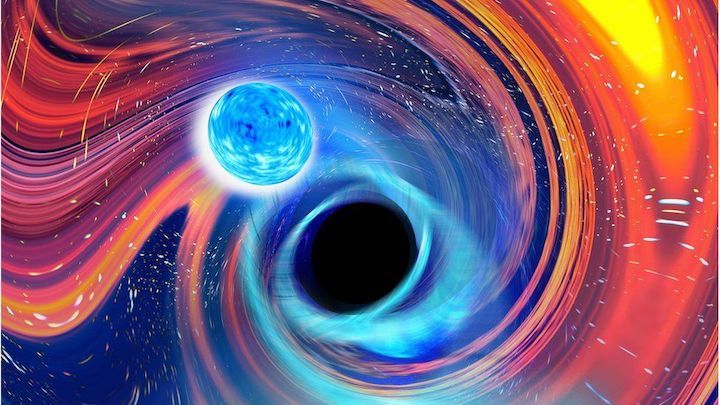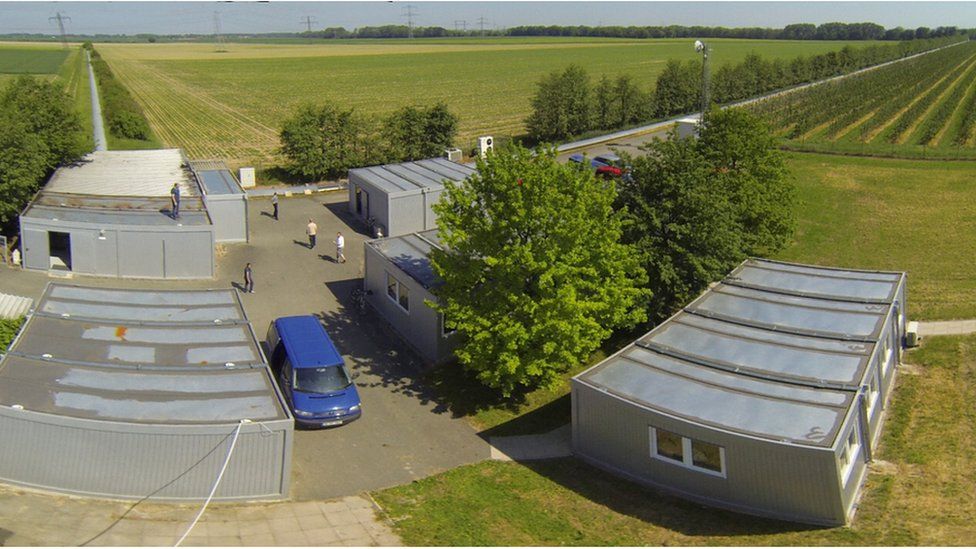1.07.2021

Scientists have detected two collisions between a neutron star and a black hole in the space of 10 days.
Researchers predicted that such collisions would occur, but did not know how often.
The observations could mean that some ideas of how stars and galaxies form may need to be revised.
Prof Vivien Raymond, from Cardiff University, told BBC News that the surprising results were ''fantastic''.
"We have to go back to the drawing board and rewrite our theories," he said effusively.
"We have learned a bit of a lesson again. When we assume something we tend to be proved wrong after a while. So we have to keep our minds open and see what the Universe is telling us."
Black holes are astronomical objects that have such strong gravity, not even light can escape. Neutron stars are dead stars that are incredibly dense. A teaspoonful of material from a neutron star is estimated to weigh around four billion tonnes.
Both objects are cosmological monsters, but black holes are considerably more massive than neutron stars.
n the first collision, which was detected on 5 January 2020, a black hole six-and-a-half times the mass of our Sun crashed into a neutron star that was 1.5 times more massive than our parent star. In the second collision, picked up just 10 days later, a black hole of 10 solar masses merged with a neutron star of two solar masses.
When objects as massive as these collide they create ripples in the fabric of space called gravitational waves. And it is these ripples that the researchers have detected.
The researchers looked back at earlier observations with fresh eyes and many of them are likely to to have been similar mismatched collisions.
 IMAGE COPYRIGHTGEO600
IMAGE COPYRIGHTGEO600Researchers have detected two black holes colliding, as well as two neutron stars but this is the first time they have detected a neutron star crashing into a black hole.
So apart from completing the set, why does this latest collision matter?
It is because, according to current theories and past observations, neutron stars tend to be found with - and collide into - other neutron stars. And the same should be true of black holes.
In fact, there are factors which reduce the chances of the two distinct objects being found together.
But the two neutron star-black hole collisions, published in the Astrophysical Journal Letters, may challenge that received wisdom.
Instead, it may lean towards another suite of theories, which assume that black holes and neutron stars are indeed found alongside each other. These alternative theories imply that stars and galaxies formed in different ways to the picture painted by standard views of how the cosmos formed.
For example, over billions of years, stars have produced many of the building blocks from which larger cosmic structures - such as planets and galaxies - are formed. The production within stars of so-called heavy elements - such as iron, carbon and oxygen - is related to the proportion of black holes and neutron star pairs in the Universe.
The force with which stars push out the material inside them when they explode is also related to this proportion of black hole and neutron star pairs. In conclusion, the new finding suggests that stars produce fewer heavy elements and push them out with less force than previously thought, which, in turn, has implications for real-world observations of the Universe.
No existing theory can perfectly explain what astronomers see in the night sky. But, according to Dr Raymond, many of the ideas can be ''tweaked'' to better fit what we now know.
Prof Sheila Rowan, of Glasgow University, told BBC News that observations of the type and frequency of collisions of black holes and neutron stars over the past six years is creating an ever more detailed picture of the dynamics inside galaxies.

"All this is giving us a rich picture of stellar evolution. This latest observation is another first for us in our understanding of what is out there in the Universe and how it came to be the way it is," she said.
The collisions were detected by measuring waves caused by the sudden changes in gravitational forces that occur when two massive celestial bodies collide. These are ripples in the fabric of space itself, just like a stone thrown into a still pond.
These so-called gravitational waves travel hundreds of millions of light years across space and were picked up by detectors in Washington State and Louisiana in the US and the Virgo detector in central Italy. Together, they form the Advanced Light Interferometer Gravitational-Wave Observatory (ALIGO) collaboration.
By the time they reach us, the ripples are tiny - less than the width of an atom. The detectors themselves are among the most sensitive instruments ever constructed.
In future, the team hopes to detect neutron star-black hole collisions which are also observed by telescopes - both in space and on the ground. This will enable scientists to find out more about the super-heavy materials neutron stars are made of.
The ALIGO collaboration comprises over 1,300 scientists from 18 countries, and includes researchers from 11 UK universities.
Quelle: BBC
+++
GRAVITATIONAL WAVES REVEAL BLACK HOLE–NEUTRON STAR MERGERS
Two new detections give astrophysicists a novel look at how stellar remnants pair up.
Astronomers have detected the first two convincing examples of black holes merging with neutron stars. Members of the LIGO, Virgo, and KAGRA collaborations (hereafter LVK) report the discoveries in the July 1st Astrophysical Journal Letters.
Scientists detected the events during the second half of LIGO’s third observing run (called O3b), the full analysis of which is still forthcoming. O3b ran from November 2019 to late March 2020. The two gravitational-wave events, dubbed GW200105 and GW200115, rippled through detectors only 10 days apart, on January 5, 2020, and January 15, 2020, respectively.

Mark Myers (OzGrav /Swinburne University)
Each merger involved a fairly small black hole (less than 10 Suns in heft) paired with an object between 1½ and 2 solar masses — right in the expected range for neutron stars. Observers caught no glow from the collisions, but given that both crashes happened roughly 900 million light-years away, spotting a flash was improbable, even if one happened — and it likely didn’t: The black holes are large enough that they would have gobbled the neutron stars whole instead of ripping them into bite-size pieces.
LVK members have reported a potential black hole–neutron star smashup before, but it’s still unclear whether it’s just gunk in the data. And last summer, they also announced a puzzling collision involving either the most massive neutron star or the smallest black hole known. (The jury’s still out, but at least some astronomers lean toward black hole.) Thus in terms of confidence level, the two new events mark a first for gravitational-wave studies.
Scientific visualization: T. Dietrich (Potsdam University and Max Planck Institute for Gravitational Physics), N. Fischer, S. Ossokine, H. Pfeiffer (Max Planck Institute for Gravitational Physics); Numerical-relativity simulation: S.V. Chaurasia (Stockholm University), T. Dietrich (Potsdam University and Max Planck Institute for Gravitational Physics)
HOW DID THEY FORM?
The black hole involved in the GW200105 event had a mass of about 9 Suns and appears to have spun slowly, maybe even not at all. That might indicate it’s the core of a collapsed star, although X-ray observations of black holes in stellar binaries problematize that.
Unfortunately, because they’re four to five times more massive than the neutron stars, the black holes in both mergers drown out clear information about their smaller companions’ spins.
Curiously, GW200115’s 6-solar-mass black hole may have spun upside-down with respect to its inspiraling orbit. Objects born as binaries are generally expected to tilt less than 30° from their orbits around each other, so the black hole’s rakish angle might mean it paired up with the neutron star after formation. However, there’s no way to know for sure, cautions team member Chase Kimball (Northwestern University).
“Misaligned spins can come about in a number of ways,” he explains. True, objects that found each other late in life are likely to tilt all sorts of directions, perhaps having switched partners multiple times as stars and their remnants square-danced through a cluster. But one star can also knock its natal buddy sideways when it supernovas or dumps gas onto it. “I can’t think of a piece of information that would let you definitively say that an individual neutron star–black hole merger came from one or another formation channel.”
But it’s the aggregate that matters. Pile up enough neutron star–black hole crash detections, and astronomers will be able to look for patterns. If many have misaligned spins, that might favor late pair-ups. LVK researchers have already done a preliminary analysis of this sort on the black holes from the latest catalog and found hints that roughly a third of the black holes caught colliding were late pairings.
The combination of data from all three types of mergers — double neutron stars, double black holes, and neutron star–black hole binaries — will be important. Whichever formation processes produce most of one binary type will likely produce many of the other sort. So once astronomers get a better handle on how often different types of mergers happen, they’ll be able to narrow in on which processes would make each type of binary at the observed rate and sketch a picture of how the systems likely formed in the first place.
Quelle: Sky&Telescope
